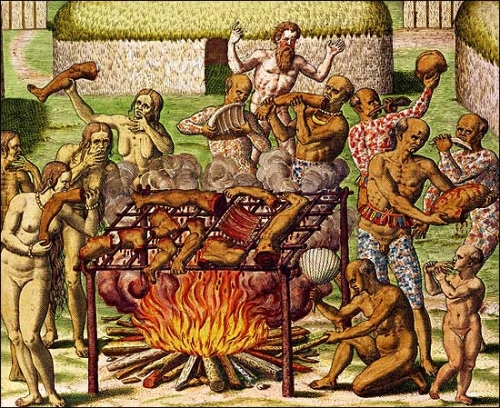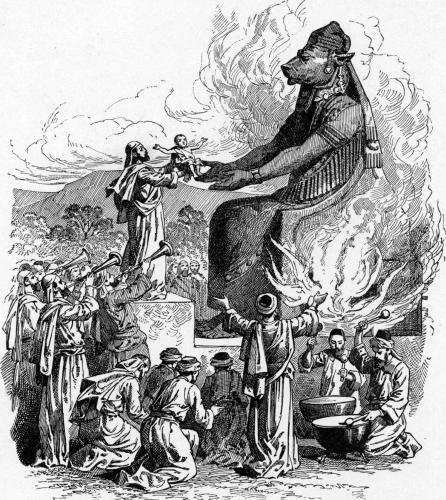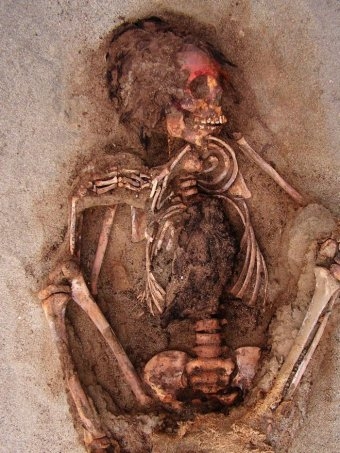dimanche, 21 juin 2020
Cannibalism And Child Sacrifice Are Obvious Evils. Why Can’t Cultural Relativists Admit That?

Cannibalism And Child Sacrifice Are Obvious Evils. Why Can’t Cultural Relativists Admit That?
The recent unearthing of the remains of sacrificed children in Peru highlights the widely known but little discussed topic of human sacrifice and cannibalism — especially of children — among native populations of the Americas.
This latest find is not unique. Evidence shows that humans were butchered and de-fleshed in the Nanchoc Valley, and at the Pyramid of the Moon, in the Moche River Valley, at the Piramide Mayor at Caral and at the Cave of the Owl in the Peruvian Upper Montaña. Human bones, charred and often shattered to extract the marrow, have been found at Los Gavilanes, Huaca Prieta, Asia, and Aspero — to name but a few places.
Further, the curious study of paleofeces, where coprolite (naturally preserved feces) is studied to determine the food available to ancient populations, shows the presence of human proteins, which can only come from consuming human flesh. Fecal samples are taken from various sites throughout the Americas.
Peru also preserves the earliest evidence of headhunting in all the three native cultures (the Paracas, the Nazca and the Huari). Given the dry climate, well-preserved heads have been found which show the process of ritual mutilation (the brain was removed through a hole in the forehead and the lips were sealed shut by two thorns). A similar practice existed among the Jibaro of Puerto Rico.

Nor is Peru unique in the practice of human sacrifice and cannibalism, for both were important features in all native cultures, throughout North, Middle and South America. Take for example, the Tiwanaku in Bolivia; the Tupi-Guarani of Brazil; the gathering of Inca children (usually little girls) as tax payment who were then sacrificed.
The Aztec cooked the flesh of victims into a stew, with tomatoes and peppers. We also have the finds at Ecatepec, near Mexico City, at Tula, at Burnt Mesa, New Mexico, at the Mancos Canyon, the Atakapa of Southwestern Louisiana, among the Tupinamba, and the Carib (the very term “cannibal” comes from the name of this tribe, whom Columbus first encountered).
Further North, there are the elaborate torture-slaughter-cannibal rituals of the Iroquois, the Huron, and other people of the Great Lakes, the Westo, the Anasazi, the plains, the Atlantic and the Pacific coasts (such as the Kwakiutl), the Pacific Islands, and even up into the Arctic, as at the Saunuktuk site. I have been privately assured by scholars who study the Pre-Contact period (before contact with Europeans) that “you wouldn’t want to be living in most parts of the Americas back then.”
This glut of evidence is processed in the mill of relativism, however, and what emerges is the intellectualization of man’s inhumanity to man, which passes for scholarly neutrality. In other words, no one can bring himself to say that one culture can be better than another, especially if that other happens to be the Western one. The exhortation is always the same: We must understand, not judge. But how do you understand children being tortured, slaughtered and then eaten? More importantly, what is there to understand?
Cultures veer into all kinds of horror shows because of weird ideologies they suddenly adopt. This usually means wholesale slaughter of the innocent. Real human beings are brutalized in order to demonstrate the worthiness of ideology. Examples in very recent human history abound: Stalinism, Nazism, Maoism, Islamism and the Armenian genocide by the Turks.
Neutrality in intellectual inquiry is another liberal confusion about the purpose of education. How can you learn anything without judgment? Philosophy shows that neutrality is an illusion (as Joseph Raz clearly demonstrates). What you have instead are choices; and you must commit your allegiance to one — and sometimes more — of these choices. Such is the progress of thought.
Those that study Pre-Contact cultures are themselves not neutral. Thave an agenda — to show how Europeans destroyed what they found.
These same “neutral” scholars also often rationalize human sacrifice and cannibalism by invoking cruelties perpetrated by European colonialists. This is simply more confusion. No one says that humans can’t be cruel, but what history does show is that this cruelty must be contained and destroyed by good ideas. More importantly, Europe of the 15th century — and later centuries — had no entrenched tradition of human sacrifice and cannibalism.

This, then, leads to the broader, yet mindless, assertion: “Who are we to say that cannibalism is bad?” To be fair, such liberal reasoning has given us, in our time, both human sacrifice and a type of cannibalism in the practice of abortion, where the fetus is killed in the womb (to placate the ideology that it’s not really human and some notion of freedom, aka, “free choice”), and then its body is put to many uses (rather lucrative ones). Such are our ideological prisons.
Likewise, the populations of the Pre-Contact Americas were trapped by ideology that transformed humans into the eaters and the eaten. It would require the input of good Western ideas to free these people from the cruel prison of their failed cultures.
This is what history is all about: the sharing of good ideas and the building of a good civilization. Together they provide the good life, which is the chief end of humanity.
Nirmal Dass is a former university professor specializing in the Early and High Middle Ages. His areas of research are philosophy, history and ancient languages. He has written several books and is actively engaged in literary translation.
The views and opinions expressed in this commentary are those of the author and do not reflect the official position of The Daily Caller.
10:12 Publié dans Actualité, anthropologie | Lien permanent | Commentaires (0) | Tags : cannibalisme, infanticide, sacrifice d'enfants, relativisme culturel, philosophie |  |
|  del.icio.us |
del.icio.us |  |
|  Digg |
Digg | ![]() Facebook
Facebook


